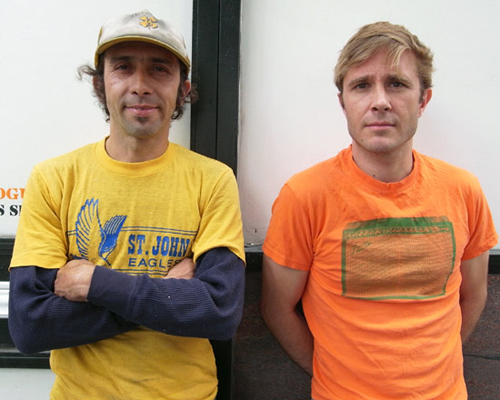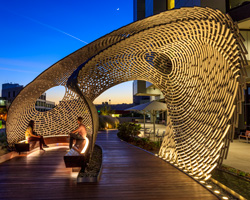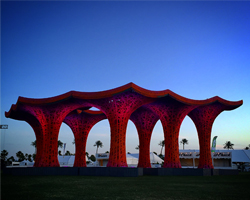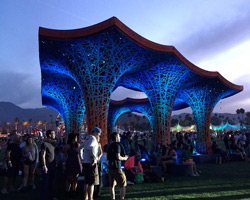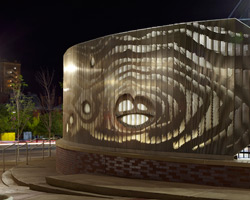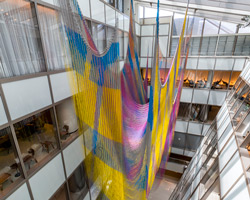gaston nogues and benjamin ball of ball-nogues studio portrait © designboom
designboom met benjamin ball and gaston nogues of ball-nogues studio in los angeles, june 26th, 2010.
(g gaston / b benjamin)
what is the best moment of the day? g: (laughs) we have a little joke. we work with another guy named ben and he calls us ‘am’ and ‘pm’ because (pointing at benjamin) he likes to work late at night, and I’m an early morning person. I have a kid so I just started getting up earlier. so together we split up the day like that. b: I feel as thought I can get a lot done at night. if we are just in production, you have to do that during the day but to write something like a proposal, I like to do it at night when nobody’s around.
what kind of music do you listen to at the moment? g:I listen to one thing until people want to kill me. I’ve been listening to michael yonkers a lot. he’s from the late 60s, I think? and it sounds, I don’t know, angry? not angry. it’s hard to describe. it’s kind of like minimalist pre-punk blues. sort of pre-synthesizer electronic music. he was really interested in tweaking available electronics. it was the beginning of people getting experimental, sonic things so he would take his equipment and chop it all up and do weird things to it. b: I love him, too. I love michael yonkers. we have a lot of the same interest in music and I think we like things that have the same spirit of the things that we do. g: we listen to ‘can’ and ‘captain beefheart’… b: n.o.e. g: n.o.e. you like lady gaga. b: (laughs) no, I don’t like lady gaga’s music; I like her music videos. g: okay, you like her music videos. there you go. I don’t really know her songs that well.
do you listen to the radio? in the office? g: sometimes NPR. lately we haven’t been putting on any music. we have so many people now that it’s hard to find something that everybody likes. one of our guys listens to dance and techno which doesn’t jive with everybody. music is really important on the way you think. these days, it’s just been machine noise which is kind of nice in itself. b: it’s very hard to listen to music in that space with so many different people. some people are writing, some are modeling, some need to be very focused.
what books do you have on your bedside table? b: right now, I’m reading this book on monuments in baathist, iraq. we’re doing a project about monuments so I’ve been reading a lot of different books on this topic. this writer looks at these terrible monuments that were created by saddam hussein which, at this point, have gone kind of kitsch. he talks about saddam hussein as an (air quote) ‘artist’ and compares him to andy warhol (laughs and shrugs). it’s very complicated. another book that I am reading is called, ‘institutional critique’ which takes institutions of art as the subject of the work and critique them (museums, galleries, and academia).
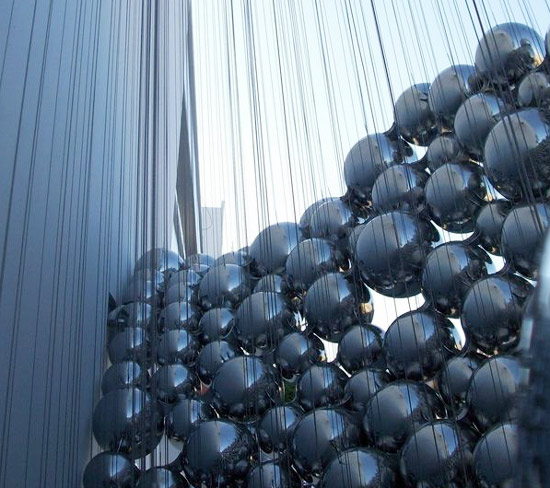 ‘cradle’ in santa monica, california, 2010 commissioned by the city of santa monica, the sculpture is situated on the exterior wall of a parking structure designed by frank gehry. image courtesy ball-nogues studio see more images of the project here
‘cradle’ in santa monica, california, 2010 commissioned by the city of santa monica, the sculpture is situated on the exterior wall of a parking structure designed by frank gehry. image courtesy ball-nogues studio see more images of the project here
do you watch TV? g: yes, I’ve been watching more TV than reading, actually. I have a 9 year old and we only let him watch science channels and the like. a lot of ‘how they do that?’ kind of shows, manufacturing shows, factories. it’s weird because there’s always this kind of program on that’s been informative to what we’re doing at the time. for example, we were playing with balloons a lot and I saw a show on how balloons were made. b: yeah, those are good. that type of programming wasn’t available when we were children. g: yeah, yeah. b: you would spend hours in the library, learning how a balloon is made. and now, because of the number of television channels available, they come to your home. g: they’ve become whole television shows, which is kind of weird to think that people would be interested in how drywall is made. but it’s neat. it’s very interesting to see things actualized in a massive scale. b: (to gaston) did you watch the show on how they make the spray paper? g: I did. b: the paper pulp project might have came out of that show. g: the shows are informative in a very basic way. they help you understand the process, distilled down to the most basic steps. it’s the beginnings of a experiment.
do you read design / architecture / fashion magazines? g: the ones that come to our studio. b: we don’t go and buy them. we don’t subscribe. it doesn’t mean that we don’t read. g: I like to not. b: yeah. g: not that I make a point of it. we still try to know about things that are going on but we try to stay away from being influenced. b: yeah g: we try to avoid having to think about other things.
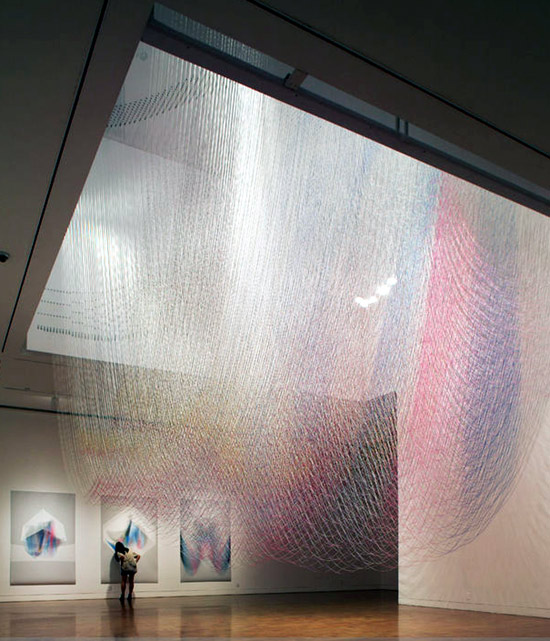 ‘feathered edge: an installation by ball-nogues studio’ at MOCA pacific design center, 2009 photo by brian forrest image courtesy ball-nogues studio
‘feathered edge: an installation by ball-nogues studio’ at MOCA pacific design center, 2009 photo by brian forrest image courtesy ball-nogues studio
 ‘feathered edge: an installation by ball-nogues studio’ at MOCA pacific design center, 2009 photo by brian forrest image courtesy ball-nogues studio see more images of the project here
‘feathered edge: an installation by ball-nogues studio’ at MOCA pacific design center, 2009 photo by brian forrest image courtesy ball-nogues studio see more images of the project here
where do you get news from? g: NPR. when we come to coffee shops, I’ll read the paper. b: new york times. and I read some blogs. BBC.
I assume you notice how women dress. do you have any preferences? g: I love how my wife dresses (laughs). b: you should see how his wife dresses. g: my wife likes costuming quite a bit so depending on the situation, she can be pretty outrageous. when she came to new york, she wore a fishnet trouser. b: REAL fishnet. not fishnet stockings, but a big fish net for fishing. g: they were from the PS1 installation that we were working on. b: she’s very interested in reclaimed clothing; taking old clothing and cutting it up, making something new. I’ve never been too interested in couture. I’ve always been more interested in things that people are doing themselves.
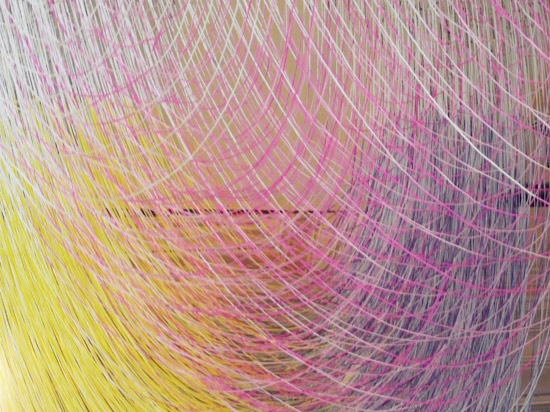 detail of ‘gravity’s loom’, 2010 the project is commissioned by the indianopolis museum of art image © designboom see more images from designboom’s visit here
detail of ‘gravity’s loom’, 2010 the project is commissioned by the indianopolis museum of art image © designboom see more images from designboom’s visit here
you mentioned that in ‘tablecloth’, the installation in the courtyard of schoenberg hall, UCLA you looked at paco rabanne’s couture. b: that’s a nice dress. you couldn’t help but think about that dress when we were developing this. I wouldn’t say that the dress was the inspiration for that project but as we started working on it, we realized that it was pretty similar.
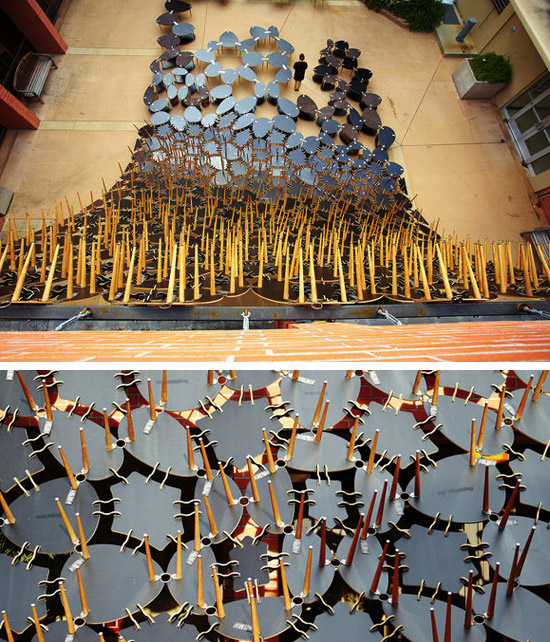 ‘table cloth’, at the university of california’s schoenberg hall courtyard los angeles, california, 2010 image courtesy ball-nogues studio see more images of the installation here
‘table cloth’, at the university of california’s schoenberg hall courtyard los angeles, california, 2010 image courtesy ball-nogues studio see more images of the installation here
what kind of clothes do you avoid wearing? g: really tight jeans. they are very uncomfortable. b: anything related to sports. except I guess these (shows sneakers).
do you have any pets? g: a dog, a rat, two cats. b: I have two cats.
when you were a child, did you want to become a designer? g: I wanted to be more like my dad. he was an engineer and I really liked what he did. he used to take me to where he worked and I would get to hang out in an hanger with a bunch of guys who worked on airplanes. I really liked that but I was terrible at math. but I think, eventually, the things that I liked to be surrounded with when I was a kid, I managed to maintain. the shop where we work is very similar to some of the places that my dad used to take me to. b: I wanted to be an architect at a very young age. and then I wanted to be a theatre set designer. I always thought I would do something artistic. my mother had me around theatres a lot. I also wanted to be a musician and play guitar. at another point, I wanted to be a political scientist. I wanted to study politics. I’ve tried just about everything. I wanted to be a veterinarian. g: I wanted to be a firefighter but that stopped when my mom took me to the fire station. a firefighter picked me up and I was done with firefighters. b: I used to want to be a veterinarian because I used to make animal hospitals in my bedroom. my mother bought me a lot of stuffed animals and I would cut them open on this operating apparatus I built. so that was a combination of veterinarian and architect.
where do you work on your designs and projects? g: at the studio. it’s very comfortable there. we like the space. it’s a good place to think. there’s something going on all the time. it gets ideas rolling. we talk to each other a lot. we evolve our ideas in the studio when we’re working on it together.
do you discuss your work with other architects and designers? g: I think that kind of scenario exists more in critiques and school environments then perhaps getting together with other designers in, say, a cafe. I think academic grounds is more common for that. we share our different views and ideas when we talk about student work. teaching is a good way to have discourse with other designers.
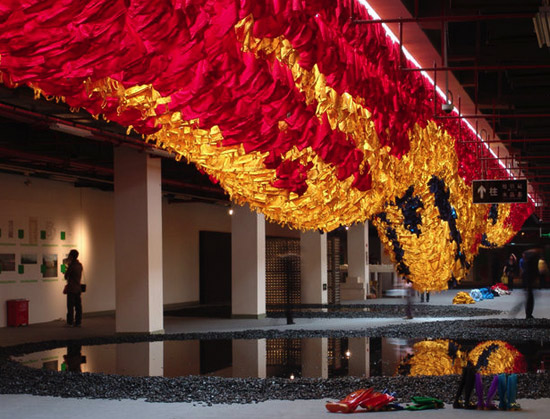 ‘built to wear’, hong kong | shenzhen biennale of architecture and urbanism, 2009 the structure is comprised of 10,000 items of clothing manufactured by american apparel image courtesy ball-nogues studio see more images here
‘built to wear’, hong kong | shenzhen biennale of architecture and urbanism, 2009 the structure is comprised of 10,000 items of clothing manufactured by american apparel image courtesy ball-nogues studio see more images here
describe your style, like a good friend of yours would describe it. g: crafty. I try to avoid talking about our work with friends, though. we have some disparate friends. b: someone would say, ben and gaston invented a contraption to make a new project. they would say our work is about inventing. ‘they’re always inventing a new kind of craft; a new way of making things.’ we do a lot of tinkering, lots of playing around with objects and taking them apart and putting them back together. once we decide on what the project is going to be, we choose a direction. then it’s very focused but we try a number of different things to get to that point. g: yeah, I think all of that comes out of a desire to make things. in that sense, we try to control all aspects of it. and things look great (laughs). they come out the way we want them to.
please describe an evolution in your work, from your first projects to the present day. g: we’ve been pretty honest to how we began. b: I think our projects have become larger in scope and more complex. people are starting to associate us with impermanence which was never something that we set out to do. it was just the opportunities and the budgets that were provided to us that determined the life of our projects. but now, almost all our commissions are for permanent projects. they are larger in scale, more complex, and require more consultants…
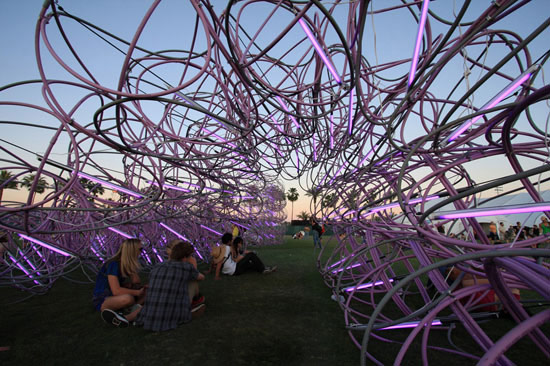 ‘elastic plastic sponge’ at the coachella valley musc & arts festival indio, california, 2009 image courtesy of ball-nogues studio see more images of the project here
‘elastic plastic sponge’ at the coachella valley musc & arts festival indio, california, 2009 image courtesy of ball-nogues studio see more images of the project here
the limitations and opportunities are arising from technology? we’re trying to move away from a discourse that’s just about technology which I find to be a very outdated way of working. the work has to be more than just discussing a new software or a new process. we’re really trying to think about the social dimension of our work, its lifecycle, and its sustainability. we want to create an experience that has more depth and more meaning.
what project has given you the most satisfaction? b: the MOCA installation. there was a moment when we weren’t sure if it was going to work. but we always take risks. we’re always trying to push just to the point of failing. g: with the MOCA project, we hit a bug with the machine – literally. well, a magnetic bug. we couldn’t fix it so we were coming up with ways to do it by hand which would have been impossible to do – we didn’t have the time. so eventually got the magnet but out … the machine is just pumping these strings out and they don’t mean anything until you put it all together. at first it’s just one string, then two, three – thousands. when it finally started to take form and we could see that it worked, it was pretty gratifying.
who would you like to design something for? g: we always considered ourselves very fortunate to have gotten to do what we have. every commission we’ve gotten, we’ve been very happy with. so in that sense, it’s hard to name an ideal client. when you try to squeeze the most out of a good project, there’s never a need for that kind of longing. b: I think it’s most important to have a good relationship with the people. it’s not so much a particular type of project – it’s the people. you could work in the best museum in the world but that doesn’t make it a good project if you have a bad relationship with the curator.
who is your ideal audience? we want to communicate to a popular audience, so a child should be able to respond to it. but we also want to communicate to an academic audience, to the ‘cognizanti’. g: and everybody in between. and if the economy goes bust, we would still be doing this (laughs). we are our best clients and we try not to rely on budget.
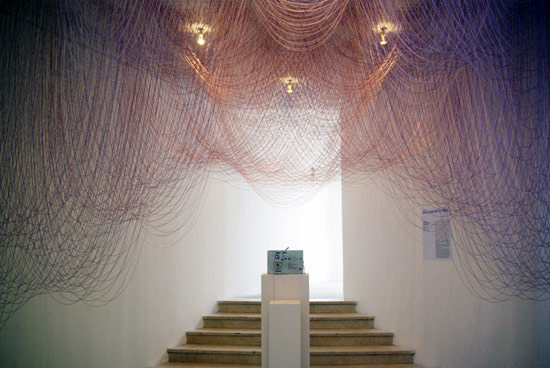 ‘echoes converge’ at the venice bennale venice, italy, 2008 image © designboom see more images of the installation here
‘echoes converge’ at the venice bennale venice, italy, 2008 image © designboom see more images of the installation here
is there any designer and/or architect you appreciate a lot? g: perhaps frank gehry. just the way he set up his studio and the way they work there. I spent a long time working in that office. they have a multi-level approach to everything. b: otto frei. we’re always interested in what he did and his methods of working. the way he went about problem solving. the details. investigating a certain material to understand its properties, the parameters within which you can work as a designer.
and from the younger generation? b: I like mark fornes, theverymany. we’re not so much interested in the style of a particular artist or designer. it’s more the approach; the way they run their studios. g: or what they conceive of as work. b: and mark allen. he has a sort of gallery, a collective in los angeles called ‘machine project’. they work in a kind of nexus, a community that is bound by mutual interests. this could be an interest in cooking, or gardening, mathematics, ad so on. they do workshops on everything, like computational crochet to baking with a light bulb. they sponsored a competition for artists, designers and engineers to create an oven that used a single light bulb. they get judged on design, efficiency, aesthetics, and then they had a food critic for taste. it’s an approach to art and life. g: yeah, and face. b: yeah, it’s farcical (laughs).
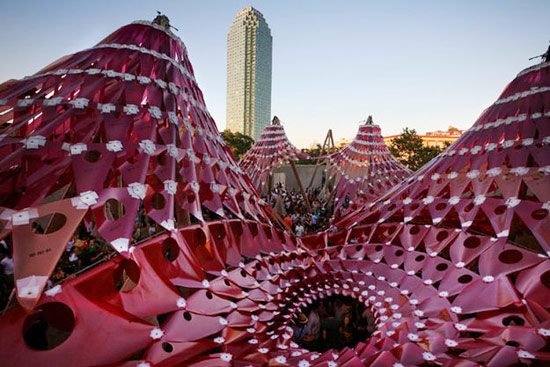 ‘liquid sky’ at PS1 contemporary art center queens, new york, 2007 the winning summer installation of the eighth annual MoMA/PS1 young architects program image courtesy ball-nogues studio
‘liquid sky’ at PS1 contemporary art center queens, new york, 2007 the winning summer installation of the eighth annual MoMA/PS1 young architects program image courtesy ball-nogues studio
what advice would you give to the young? b: work hard, kids. b: people often ask me that question and I’m still trying to figure it out. g: I’m giving advice to my kids right now. two of them. one of them doesn’t reply at all and the other one needs to basically work hard. it’s all a lot of work. b: I think it’s very important to not be constrained by categorization. I think categories that define people in a particular way can kill a lot of good, creative inspiration by trying to fit into a specific group. ‘I’m not going to do this because this is what an architect does’ or ‘this is what an industrial designer does’, ‘this is what an artist does’. that type of thinking can be very limiting for people. I would always encourage everyone to be critical of categorical thinking. g: yeah. another thing that’s going on is people are starting to disassociate their hands from their brain. b: yes! very important. g: you’re seeing a lot of people who believe it’s good enough to be able to just press a button. there is no sense of meaning, materiality, or gravity in what they make. I think it’s always important to balance those things out – but not entirely. you should be able to dream as well.
you mean, if you look at modern architecture, for example, there are forms that our brain would never have created/controlled because we have no experience of making them by hand. if you were to draw them without a program that could think for you, you would have done something completely different? g: yeah, when I first started working, you had to employ an analogue way of thinking and templating. very difficult. what I’ve found was when you do these things by hand, the approach is very similar to the one that you would have taken digitally. they both inform one another; it’s not completely disassociated. b: we don’t have an anti-digital view on things. we just recognize that, sometimes, to make things, you have to understand how they are made. and sometimes you can learn so much more by actually working with real materials. that, combined with the ability to expand your imagination with a computer is important. you’re expanding your capacity to visualize things that could never be visualized without one – but this can go too far. you can end up in a world that is pure speculation which is not something that we’re interested in.
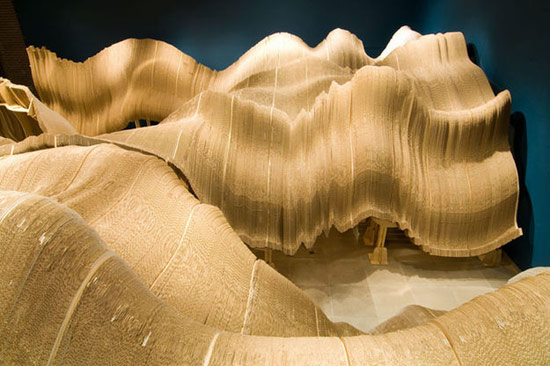 ‘rip curl canyon’ at rice university art gallery houston, texas, 2006 image courtesy ball-nogues studio
‘rip curl canyon’ at rice university art gallery houston, texas, 2006 image courtesy ball-nogues studio
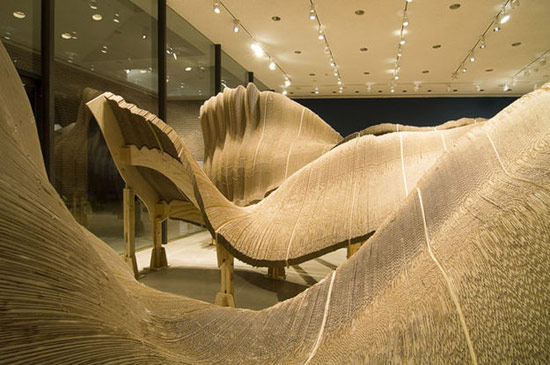 ‘rip curl canyon’ at rice university art gallery houston, texas, 2006 image courtesy ball-nogues studio
‘rip curl canyon’ at rice university art gallery houston, texas, 2006 image courtesy ball-nogues studio
what are you afraid of regarding the future? g: lot’s of things. (pointing at benjamin) why don’t you start? I’m going to think about it for a little bit. b: it always comes down to your own paranoia, I think. g: yeah. b: I’m afraid of being isolated and being completely alone (laughs), but I also think about environmental degradation to the point where we cannot survive as a specie. b: yeah, you start to think about that, especially when you have kids and the idea of that becomes more real. that’s always a concern. I think most people’s fears would be being 80 years old and having no one around. g: oh god. b: that’s a terrible feeling. g: with alzheimer’s. b: yeah. g: hate it. who would want that? b: being old and lonely. I think that’s a legitimate fear. g: (laughs) I’m afraid of falling off my bike everyday when I get on it. everyone drives so badly. that’s always very scary. but, you know… I can always survive that.
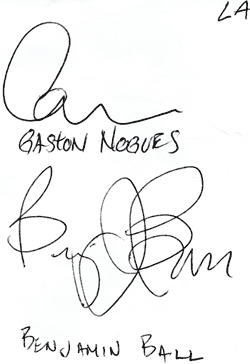
ball-nogues studio is comprised of benjamin ball, born in 1968 in waterloo, he grew up in colorado and iowa, and gaston nogues, born in 1968 in buenos aires, argentina, where he was raised before moving to los angeles at age 12. they met as students at southern california institute of architecture (SCI Arc), los angeles, and are former employees of architect frank gehry at gehry partners. ball earned his bachelor of architecture in 1994 and worked at gehry partners while completing his degree. after graduating, ball went on to work as a set and production designer and art director for films, music videos, and commercials. nogues earned his bachelor of architecture in1993, and moved directly from school into a position in product design and production at gehry partners. ball and nogues joined forces in 2005. in their current collaboration they are exploring the intersection of architecture, art and product design through physical modeling and the use of digital and more traditional forms of production. ball-nogues is the recipient of two los angeles AIA design awards. in 2007, their installation ‘liquid sky’ was the winner of the museum of modern art / p.s.1’s young architect’s program competition. in 2008, their site-specific installation ‘echoes converge’ appeared at the 11th venice biennale of architecture and they have exhibited at bejing biennale, capc /arc en rêve centre d’architecture bordeaux, and the hong kong / shenzhen bi-city biennale of architecture and urbanism. the partners have taught in the graduate architecture programs at SCI Arc, UCLA and USC. both live and work in los angeles, california.
ball-nogues studio (19)
PRODUCT LIBRARY
a diverse digital database that acts as a valuable guide in gaining insight and information about a product directly from the manufacturer, and serves as a rich reference point in developing a project or scheme.
